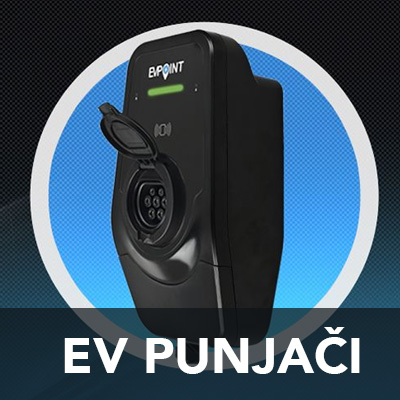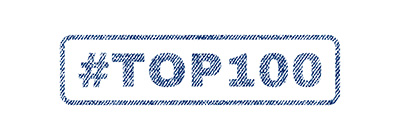What we're going to do is take you back, right back... to the 1990s where the fashion was vivid, the music powerful and the motorcycles bangin
You’re suffocating in an o-zone layer hole punching of hairspray, the Es are good Es are good, E’s Ebenezer Goode and the ‘in’ colours are all over them, preferably fluorescent.
It is also the decade motorcycles started to evolve more quickly, shifting generations that went with the fashions and technology wowed us frequently.
Indeed, this was the decade that had it all, from Foggy dominant in WSB and a packed Brands Hatch, to rotary Nortons smoking the Race of Aces; from a resurgent British biking industry (with Triumph) to some of the best sports 750s ever; from radical biking icons such as the 916 and RC45 to some radical biking disasters, such as Yamaha’s GTS 1000 and Bimota’s bonkers Mantra.
However, which were the best and by that we mean TOTALLY 90s in style, innovation and thrills that made us think we were living in a fantastical future (now of course super dated!)?
Here’s our personal pick of 10 of the best, in chronological order…

Yamaha TDM850 [1991]
Yamaha has a habit of coming out with off-the-wall twins – TR1, TDR etc – and they did it again by kicking off the 1990s with this oddball, Super Ténéré-derived street trailie.
Although never a great success, surviving in enlarged 900 form right up to 2012, it was actually a decent bike with funky looks, 77bhp, entertaining handling, impressive versatility and, with hindsight, was years before its time.
Today’s mega-popular Tracers share more than a little of its DNA while Honda’s imminent, Africa Twin-based NT1000 is a shameless rip-off. At the time, though, testers didn’t know whether to wear road or motocross boots and confused smart Alecs dubbed it the ‘Tedium’.
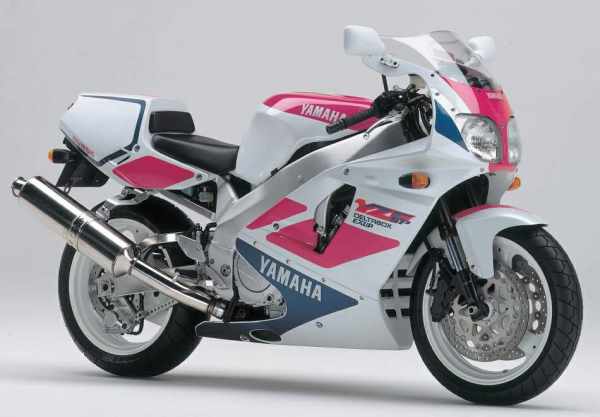
Yamaha YZF750 [1993]
Sad to realize it now but the early 1990s also saw the final fabulous fling for that once most brilliant sports class of all – 750s – and arguably the best of them all (certainly in mass market terms) was Yamaha’s 1993 YZF.
The 750 class had been a ‘thing’ ever since Honda’s original CB750 superbike of 1969 followed by the creation of the F750 racing class, and then cemented in stature by the likes of Kawasaki’s H2 Mach IV, Suzuki’s GS750, Yamaha’s XS then even more so with 1985’s GSX-R750 and Yamaha’s FZ.
The launch of WSB in 1988 on a production 750 formula took things to the next sporting level inspiring the RC30, OW01 and more, but the best 750 sportsters of all came in the 1990s with the ZX-7R, YZF, RC45 and GSX-R SRAD.
For our money the YZF, although a latecomer, was the zenith, with gorgeous styling (including typical 1990s colourschemes), a free-revving 120bhp four, six-pot brakes, exquisite Deltabox chassis and so on.
Meanwhile, a special SP version had Ohlins, single seat, flatslides, adjustable swingarm pivot and more. WSB aside, it won everything, too, including BSB (with Whitham/Mackenzie), the Bol D’or (the Sarron brothers), Suzuka (Edwards/Haga) and, in the hands of a certain E Lawson, even the Daytona 200.
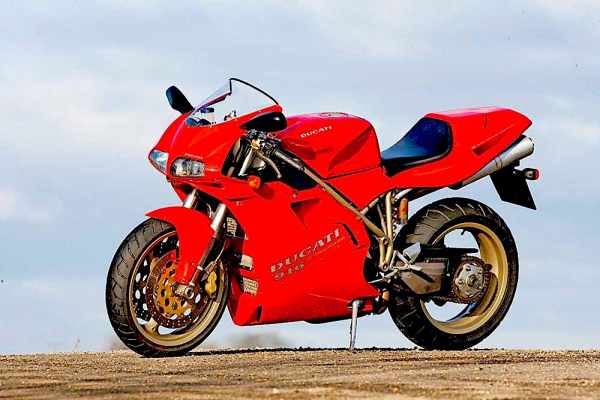
Ducati 916 [1994]
Yes, it’s been said a million times before but no motorcycle of the 1990s is more celebrated, successful and symbolic of that decade than Ducati’s simply iconic (and over-used word, but appropriate here) 916.
You surely know the story now, so we’ll skim over it: the updated successor to Massimo Bordi’s masterpiece, the already hugely successful, ‘Desmoquattro’-powered 851/888, was penned by design genius Massimo Tamburini (with, he admitted, more than a little influence from Honda’s NR750), was distinguished by its sexy slim styling, under-seat exhausts and single-sided swing arm and, conveniently, was perfectly placed to exploit the then WSB racing rules to the max.
Britain’s Carl Fogarty, with four 1990s crowns, benefitted most, but there was also another for Troy Corser and a last ‘hurrah’ in 2001 for his namesake Bayliss.
By then Honda had come up with the SP-1/2 specifically to dethrone it and soon after the rules were changed to a formula which favoured fours. In the mid-1990s, however, nothing came close.
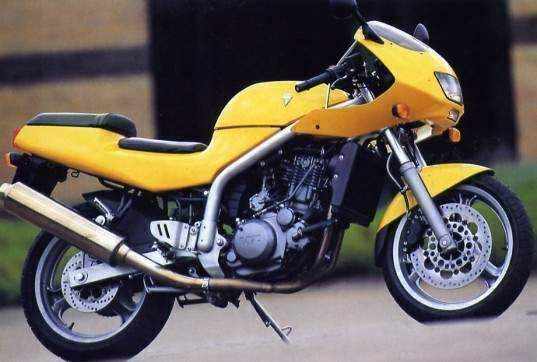
MZ Skorpion [1994]
Street supermotos weren’t the only big four-stroke singles to be fashionable in the 1990s – there was also (albeit briefly) a bit of a fling for single cylinder sportsters, too.
Gilera’s 500 Saturno first emerged in 1990 but, although cute didn’t really catch on. Then, from 1994, and partly fuelled by the then popular Sound of Singles race series, more followed, including Ducati’s gorgeous, race-only Supermono of 1995, Yamaha’s oddball but entertaining SZR660 of the same year and, arguably the most significant of them all, the British-designed but German built MZ Skorpion of 1994.
Originally intended to be badged BSA (don’t ask, it’s a long story) it was designed by Seymour-Powell, the same UK outfit behind the styling of the Norton F1 rotary, had a novel glued frame, punchy five-valve engine (from the Yamaha XTZ660 trailie), handled well, was good fun and reasonably cheap.
As a result, for a while in the 1990s, sports singles were again in fashion… until we once again realized they were also a bit pointless and impractical, that is.
![Bimota DB3 Mantra [1995]](/images/blog/10moto-90/f14695b5a455b9b6245baae7b94ea2e7.jpg)
Bimota DB3 Mantra [1995]
Think ‘1990s motorcycles’ and I defy anyone to come up with something more symbolic than Bimota’s bonkers and yet brave and somehow brilliant DB3 Mantra.
The Italian specialist’s first Ducati-engined bike since the brilliant, company-saving DB1 of 1985, it was, unusually for the sports-focussed firm, a roadster based around the air-cooled 900SS engine and, considering the success of Ducati’s own 900SS-powered Monster which came out the previous year, great things were hoped for it.
Unfortunately, however, the Mantra’s styling, by designer Sacha Lakic, which included air-intakes it didn’t need, a pouting fairing and, most infamously, a classic car-style walnut dash, was considered far too extreme, as was its £13K+ price tag (when the Monster cost around half that) and sales as a result were poor.
As a 1990s signature motorcycle, however, there are few better.
![Aprilia RS250 [1995]](/images/blog/10moto-90/162413043227a81fe3f57bfc506-19-2021-Aprilia-RS250-A-GC.com-4.jpg_copy_2.jpg)
Aprilia RS250 [1995]
As well as the 1990s signifying the last post for sports 750s the decade also delivered the final flourish for those much-loved loony’s 250 two strokes and the best, certainly of those officially imported in the UK, was Aprilia’s brilliant RS250 of 1995.
With an RGV250 V-twin engine, fine-handling (and gorgeous) polished aluminium frame, top spec cycle parts, mouth-watering styling and a GP racing pedigree that included Loris Reggiani and Max Biaggi (you could even buy the RS in a Max replica Chesterfield colourscheme), the RS was another of those bikes that, simply, had it all.
Yes, Japan-only ‘grey imports’ such as Honda’s NSR250 MC28 and Yamaha’s V-twin TZR250R also have strong claims as ‘ultimate 250 stroker’ but the Aprilia was the most accessible and arguably best all-rounder.
Unfortunately, too, it would be short-lived, emissions regs killing off the class and the RS, although surviving through one facelift, finally biting the bullet in 2004. But it was brilliant while it lasted.
![Suzuki GSF600N Bandit [1996]](/images/blog/10moto-90/6d94c7205bb4ae8cbfa2198d43f6d3c2.jpg)
Suzuki GSF600N Bandit [1996]
Bikes that do it all yet are also bargain-priced and desirable are rare. In recent years only Yamaha’s MT-07 has managed to achieve it all. But the first, coming in the 1990s, was undoubtedly Suzuki’s brilliant Bandit 600 of 1996.
A brilliant blend of affordable but more than adequate off-the-shelf components, chiefly the GSX600F’s four-cylinder engine, were ‘repurposed’ as a simple but smart roadster that was fun, versatile, both a great first big bike and an adequate commuter and, best of all, cost just £3999.
As one magazine’s cover line of the time said: ‘Laughing all the way to the bank’. Suzuki then cleverly followed it up with a half-faired version and two similar 1200s and, perhaps unsurprisingly, all were big hits.
So much so, in fact, that the 600 proved the catalyst for a whole new class including Yamaha’s 600 Fazer and Honda’s CB600F Hornet. The motorcycling world hasn’t been quite the same ever since…
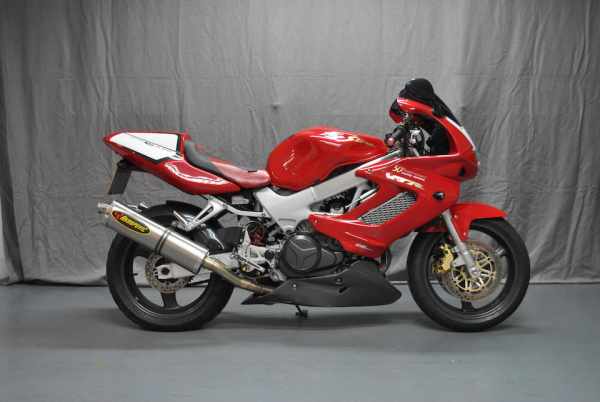
Honda VTR1000 Firestorm [1997]
If anyone needs any further indicator of the success of Ducati in the 1990s, not only with its 916 but also with its Monster and 900 Supersports, they should look no further than the spate of Japanese ‘Ducati copies’ towards the end of the decade.
The ultimate was arguably the Honda SP-1 which debuted in 2000 and won the WorldSBK crown first time out, but there are earlier bikes which were arguably even more significant.
First, in 1997, Honda came out with its take on the Ducati-style road sports V-twin, the VTR1000 Firestorm, a brilliant bike even if early versions were blighted by a too-small tank.
But then Suzuki wound up the wick first with its flawed TL1000S then with the full-on sports version, the TL1000R. Both actually proved disastrous due to a combination of slappy-happy handling caused by flawed rear suspension and, in the R’s case, too much weight and weird styling.
But their engines were brilliant and together they confirmed the longitudinal V-twin as the engine of the 1990s.

Aprilia RSV Mille [1998]
Our final decade-defining bike of the 1990s is another longitudinal V-twin and, sadly, yet another failure. After the RS250, by the mid-1990s ambitious but until then lightweight Italian manufacturer Aprilia was ambitiously eying compatriot Ducati’s superbike success so decided to build its own.
The resulting RSV Mille was powered by a powerful, 128bhp, Rotax-built, 60-degree V-twin which was held in an exquisite, polished aluminium frame with top spec cycle parts and, er, slightly unusual styling.
It was more powerful than Ducati’s 916, better equipped, more comfortable, worked well both on road and track, too and spawned an impressive, hastily-developed family of Aprilia V-twins including the SL1000 Falco, RST1000 Futura and, later, the ETV1000 Caponord. Aprilia had ambitions to be ‘Italy’s Honda’.
Unfortunately, though, good bikes, they were all also flawed, the Mille never won the WorldSBK crown it craved, Aprilia over-reached itself and, in 2004, floundered to be taken over by Piaggio. But those late 1990s Aprilia V-twins are as illustrative of the 1990s as any other.
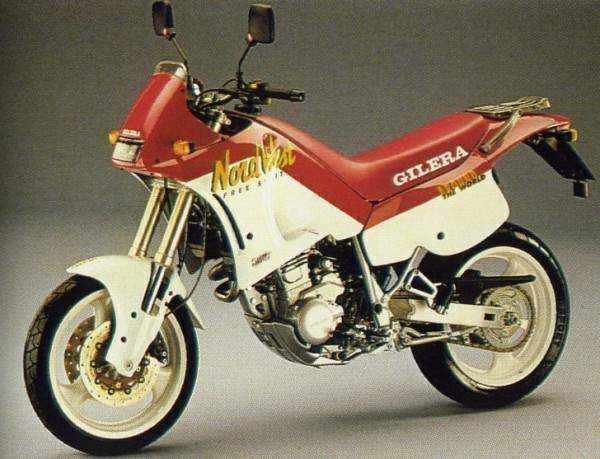
Gilera Nordwest 600 [1992]
Street supermoto singles may come and go with Husqvarna monopolizing the breed these days, but in the early 1990s they were at their most popular… though this has certainly continued in the decades thereafter.
Come 1994, the maddest, baddest and most raucous of all was the Gilera NordWest, which popped out in 1991 with a feisty 50bhp, quality cycle parts, effective Brembo brakes and adjustable suspension, plus a slick look compact look that caught the eye and dazzled in a variety of snazzy off its time ‘shellsuits’.
It was great fun, too, albeit ridiculously impractical and while it it attracted its fair share of rivals, the snarly terrier could bark them at bay for a time. KTM responded with the 620 Duke in 1995, without which the Austrian firm propelled itself into the future and would never be the same.
Unfortunately the same can’t be said for Gilera who, after other 1990s bonkers-ness including the 1990 CX125, had its historic factory at Arcore closed by parent company Piaggio in 1993. Nonetheless, the the roots remained steeped in heritage, ensuring it remains a much loved brand today.
Izvor: www.visordown.com



